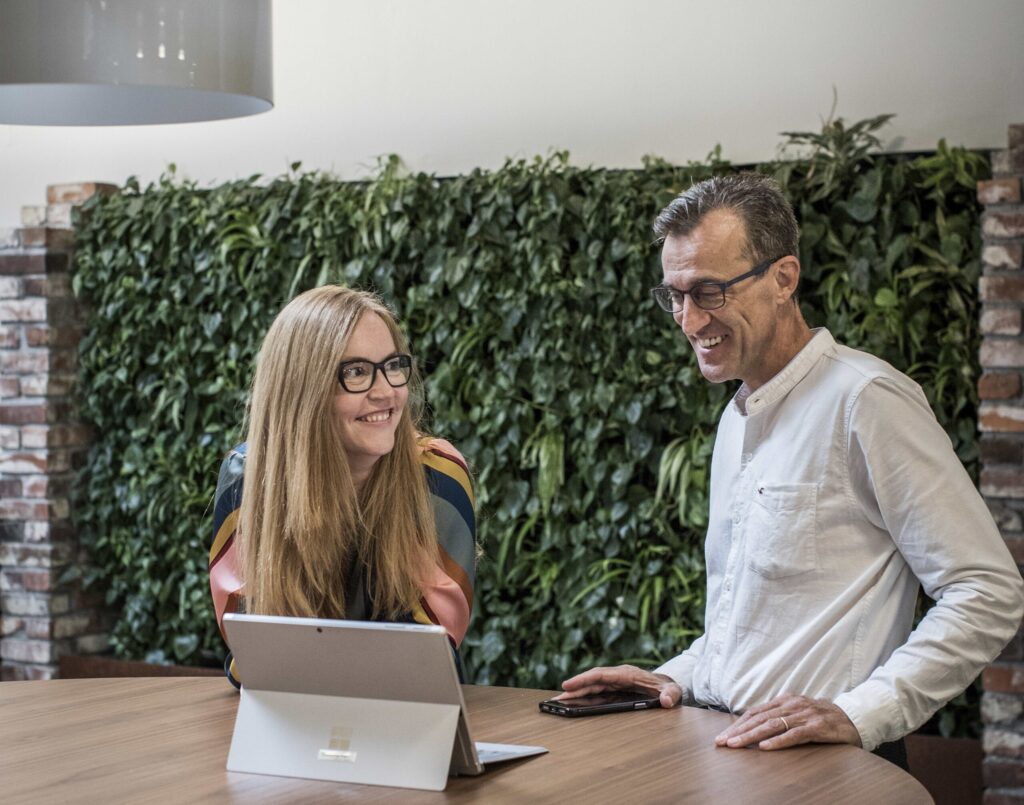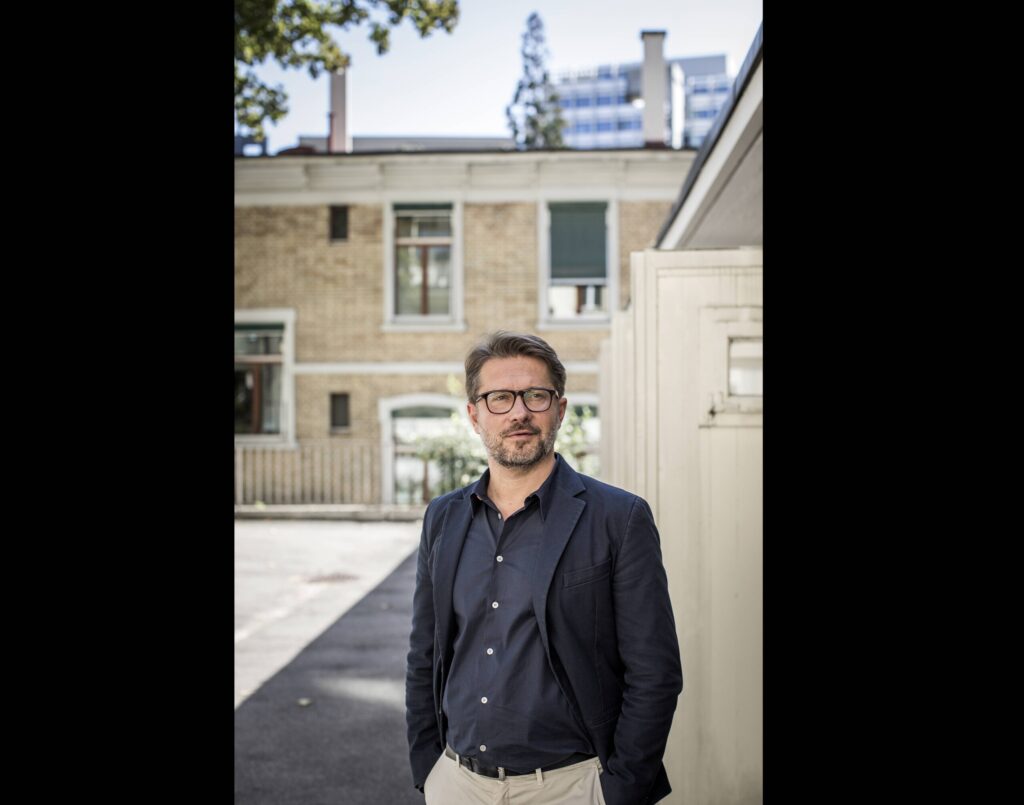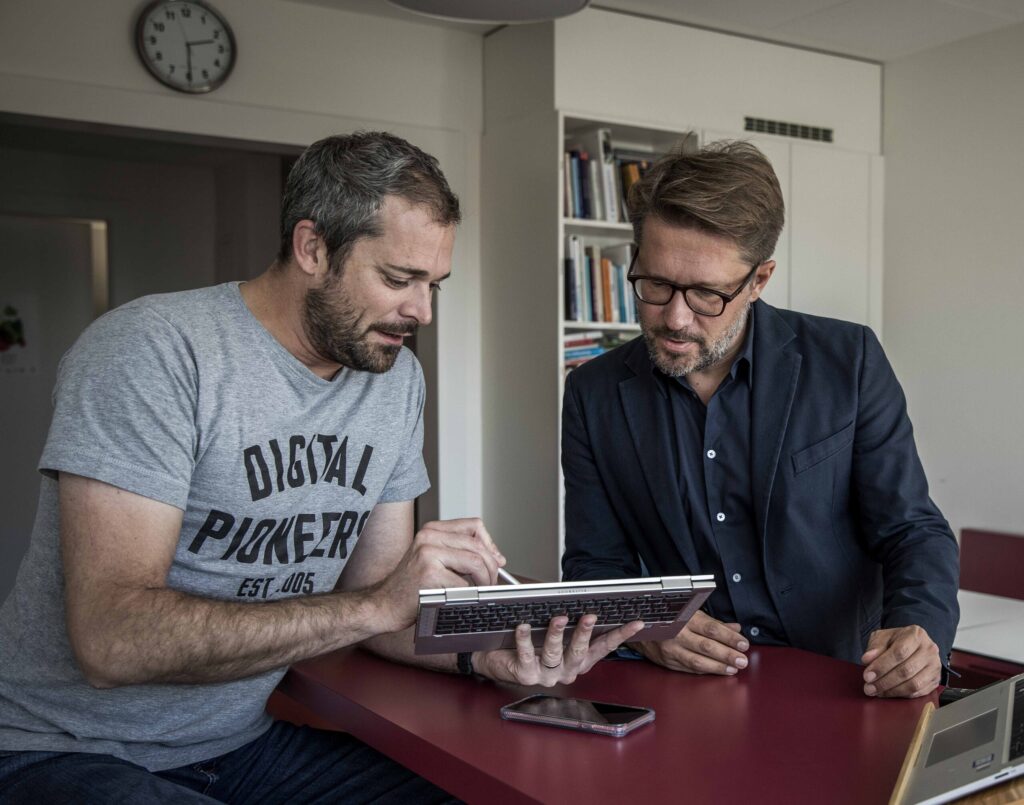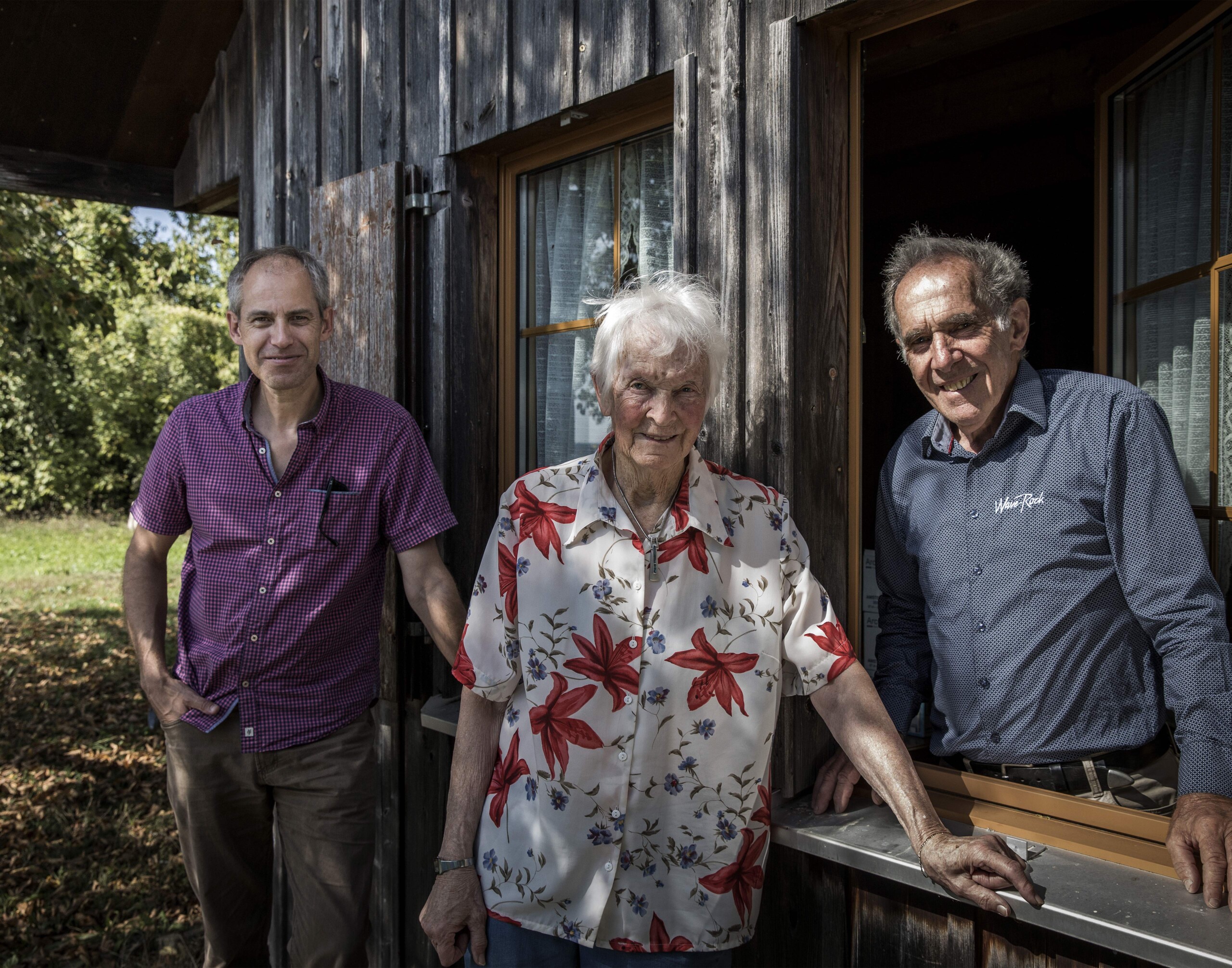In a place where huge machines previously inked letters onto paper, bright whiteboards and big screens now invite us to formulate our thoughts and ideas and share them with others. Even though it may well be a coincidence, our shift to being a digital society can hardly be illustrated in a more stereotypical way than with reference to the demise of printers. Fondation Botnar set up office in a former printers’ shop in Basel’s old town two years ago. It is flexible, light and modern – a work environment that meet the needs of today.
Karin Schumacher is Chief Operating Officer at Fondation Botnar, and she worked with the entire team to design and create the office. However, their task was more conceptional than construction-based. ‘We wanted to create space for agile processes,’ she says. Collaboration needs to work just as smoothly within the office and away from it in a decentralised fashion, when team members are out and about. New digital tools form the basis of this. Schumacher had to rethink everything from the very beginning to make this a success. ‘Things did not always run to plan. But that is part of it,’ she says. ‘We wanted to have room to experiment and to be able to make mistakes.’


New questions, new potential
The world of charities is heterogeneous. Charities’ objects are as varied as the 13,000 charities registered in Switzerland. They respond to the question of how to approach digitalisation in a similarly diverse way. Communication, collaboration, projects: new questions pop up in every area. What are the opportunities opened up by digitalisation, and where are the challenges to be found? And how can a charity make use of the potential on offer? At present, it would appear that charities are at different stages of digitalisation, and that they are each focusing on particular areas.
Opportunity goes hand-in-hand with responsibility
A newly established charity can approach this question and work through it from the bottom up. Although it was not a newly established charity, Fondation Botnar found itself in a situation where it could, and had to, reposition itself. Marcela Botnar founded the charity as far back as late 2003 with an endowment fund of 25 million Swiss francs. Marcela was the widow of Octav Botnar, who had earned his wealth by importing and selling Datsun and Nissan cars to the UK. The couple were philanthropists. When Marcela, Botnar’s widow, died in 2014, she left all her assets to Fondation Botnar. The funds available to the charity swelled overnight to around 3.2 billion Swiss francs. But with this money came responsibility: the charity had to reinvent itself. ‘We gave a lot of thought to the expertise, skills and processes we would need to be able to handle the charity’s funds both professionally and transparently,’ says Karin Schumacher. The team was put together as part of a meticulous process and has been in its final form since summer 2019. When they were designing their work processes, the charity undertook in-depth discussions as a team, drawing on the experience and expertise of its employees who had worked in other charities, private companies and NGOs previously. These processes are now the channels through which Fondation Botnar gives out funds amounting to around 60 to 70 million Swiss francs every year.
Rethinking collaboration
Very few charities have opportunities like those offered to Fondation Botnar. Many do not even have their own offices, and often, charity work is undertaken on a voluntary basis. ‘Trustees are focused on their careers. They need to be able to work in a decentralised manner,’ says Katharina Guggi, responsible for communication and digital strategy at SwissFoundations. She adds: ‘New digital communications tools offer a huge advantage in terms of collaboration at charities because they make it much easier to work in a decentralised fashion.’ The SwissFoundations association now encompasses 170 charities using their funds to support external projects. It is based in Kirchgasse, in the heart of Zurich. When Katharina Guggi started her role two years ago, she needed to work through the data at hand, view it and structure it – and all in non-digital form. It was clear to her that SwissFoundations needed to explore how things worked at the charity itself. Digitalisation means that change at every organisation needs to start with the employees themselves. After all, if you want to tap into the potential offered by digitalisation, you do not just need to digitalise the processes you previously used. You need to rethink collaboration proper. Digitalisation is always about change, and change often goes hand in hand with insecurity and internal resistance. First and foremost, it means using new tools yourself, getting used to them, and embedding these new opportunities in your day-to-day life.

Part of digitalisation
Wherever possible, Katharina uses Slack instead of email, stores data in the cloud and handles projects digitally in Trello, the online kanban system. These tools all share a high level of transparency. Everyone involved can see where a project is at in Trello, and everyone who is a member of a particular Slack chat can follow the discussion there. The situation described by Andrew Holland, Director of Mercator Switzerland, sounds rather similar. The charity was founded in 1998 by the descendants of Karl Schmidt, a German family of traders and entrepreneurs, and is based in Zurich. Last year, they supported charitable projects with funding to the tune of 19.5 million Swiss francs. Andrew Holland: ‘On a systematic level, digitalisation begins in the office itself. We see ourselves as part of digitalisation. The new ways of organising our work and the use of modern collaboration tools are already part of our everyday lives.’ They want to use these tools to break down the complexity of modern topics. In the office, digitalisation occurs on three levels: in processes and products, in ways of work and structures, and in culture, governance and management.
A charity with an unusual founding story
Digitalisation changes culture, but this process of change can be triggered by a change in staff. Small charities, in particular, are shaped less by personal commitment, so a change to (generally small) teams can encourage digital development. The ‘Stiftung der 5. Europameisterschaften für Sehbehinderte 1989 in Zürich’ is in the midst of this transformation at present. Its name hints at the unusual story behind how it was set up: ‘It started with a company event for Holderbank Kies + Beton AG,’ says the new chair of the board of trustees, Rolf Zuberbühler. To mark its 25th anniversary, the company wanted to support sport for visually impaired people instead of throwing a huge party. Holderbank Kies + Beton AG provided the infrastructure for the fifth European Championship for the Visually Impaired in Zurich. ‘Unexpectedly, there was some money left over at the end,’ Zuberbühler goes on, explaining the charity’s origins. The charity was sustained through personal commitment. Walter Bosshard, supported by his wife Verena, led the charity for three decades alongside his fellow trustees, offering innumerable hours of voluntary work. Digitalisation as a topic was not on the table back then: invitations and documents for meetings came in paper form, and they were delivered by the postman. The charity’s storage system consisted of a row of lever arch files. Everything always worked, thanks to responsible administration.

From lever arch files to digital storage.
The charity’s clearly defined object (to aid visually impaired people) means that it approves a high percentage of applications. ‘It has handled around 500 requests for assistance over the past 30 years,’ says Zuberbühler. ‘The charity provided assistance in around three-quarters of cases.’ However, charities are faced with increasing requirements in terms of administration, and new trustees are used to new forms of collaboration. As a result, it cannot be seen as a surprise that digitalisation has taken hold as older trustees have been replaced with new ones. Invitations, minutes and requests are all distributed digitally today. There is even a digital storage system in the making, which the board of trustees can log into. The charity’s external appearance is also being spruced up. It had barely made people aware of its existence previously, but its website is currently in the planning stage to help project owners and individuals to be able to find the charity easier. Rolf Zuberbühler says: ‘It will enable people to see both the charity and its work.’
The website is the basis
The need for communication can vary from charity to charity, with its website being the basis of digital communication to the outside world. Social media has led to additional online channels being added to this: digitalisation has radically changed the way we communicate. Fixed sender/recipient models have served their purpose. Modern-day communication is shaped by dialogue, enabling charities to discuss issues with their target groups quickly. A website alone is no longer enough, says WWF Schweiz. Instagram, Facebook and LinkedIn enable them to gather feedback immediately and specifically target their communication. The World Wide Fund for Nature is one of the world’s largest environmental organisations. ‘We’re determined to ensure that people and nature can thrive together, for generations to come’: this is their mission. The WWF deals with a topic that is currently on the public’s radar and is part of public discourse.
On the one hand, social media presents the chance to react to opportunities at short notice, and, on the other, digital communication can be well planned as part of a marketing strategy. Of course, being interactive also involves risks, as both private individuals and organisations alike can be left facing a crisis.
The digitalisation of projects
All in all, charities are not very active on social media, as data from SwissFoundations reveals. Ninety percent of its members do have a website, which is a very high figure compared to the overall Swiss average of 15 percent. However, its members are not particularly present on social media, with three-quarters of them not active on these channels at all. The WWF emphasises that, while digital communication has potential, you cannot underestimate the value of traditional channels. In addition, the WWF adds that digitalisation is not limited to Facebook, Instagram and websites. Today, the WWF sees investments in digital innovation as also encompassing ways that it can reach its objectives. Sensors, drones and AI are tools that the WWF is using already. For example, the WWF can use drones to better monitor the population of river dolphins in the Amazon, and, in China, AI-assisted photo traps help it to record the animal population automatically. The WWF is convinced that these tools might help it to boost the impact of its projects.
Digitalisation cannot be viewed in isolation
The digitalisation debate also affects charities’ discussions about their impact in the present day. Impact is hugely important on an international level. However, we are slowly but surely heading towards ‘smart’ charities. The digital transformation is picking up pace in the charity sector, as Katharina Guggi states, and charities are positioning themselves accordingly. Katharina Guggi: ‘Charities like Mercator Schweiz are explicitly creating offices to focus on the societal challenge posed by digital transformation.’ They are also being specifically associated with the charity’s objects and its projects. Torben Stephan is head of the digitalisation and society programme at the charity Mercator Schweiz. ‘At Mercator, we see digitalisation as an interplay between technology and society,’ he says. ‘For us, the key question is how we want to live alongside each other within an increasingly digitalised society in the future. That is why digitalisation is a cross-sectoral issue, involving every major topic (education, communication, collaboration, environment) that affects a charity. It cannot be viewed in isolation. Just as internal forms of collaboration are changing, Mercator Schweiz’s projects see digitalisation having an impact on civil society, in particular. Civil society is a complex beast, located outside the commercial marketplace and state structures. Digitalisation gives civil society new opportunities to express itself and interact. Andrew Holland: ‘This means that civil society will gain the skills and knowledge it needs to accurately weigh up the opportunities and challenges offered by digitalisation and play a role in positively shaping changes.’
Fighting the ‘digital Röstigraben’ dividing Switzerland

The board of trustees at Mercator Schweiz has developed and signed off on a new programme with the aim of better equipping civil society in this regard. There are two million Swiss francs a year at its disposal, with this figure reaching a total of ten million Swiss francs over the planned term of five years. The programme consists of three strands: the first is that the wider public’s participation in digitisation should contribute to bridging the gaps between cultures. ‘The aim is not to leave anyone behind. At the moment, we are focusing on teaching skills, like data skills,’ explains Torben Stephan. There are also projects to minimise the urban/rural divide and avoid the creation of a ‘digital Röstigraben’, a modern-day equivalent of the division between French- and German-speaking Switzerland. The second involves looking at major issues for the future, like artificial intelligence, the blockchain or digital values debates, from the perspective of civil society. Torben Stephan: ‘It is important that civil society forms an opinion on these issues, playing an active role in the space between the worlds of politics, business and research.’ According to him, the business world predetermines the outcome of many issues at present. Thirdly, the aim is to use technology in the service of society: innovation for the greater good.


Swelling charities’ coffers
Digitalisation also enables civil society to make use of new ways to finance projects. Rea Eggli, co-founder of wemakeit says: ‘Our crowdfunding platform wemakeit is the ideal counterpart to charitable funding; we do not see ourselves as a competitor.’ wemakeit has been enjoying a practical collaboration with a charity for two years thanks to the ‘Science Booster’. The ‘Science Booster’ sees Gerbert Rüf support successful scientific projects on wemakeit.com, doubling every Swiss franc donated by the public. Public-private partnerships are also an option. For charities themselves, wemakeit is a digital platform where they can discover new projects, as a search subscription with keywords helps them to find innovative projects to support. This is one reason why partnering with wemakeit can be an exciting prospect for a charity, whether in terms of finding an issue to support or making it easier to process competitions between project owners. A charity can even tap into new target groups with crowdfunding. wemakeit currently has a community of more than 300,000 people. The chance that a project reaches its self-imposed goal is 61 percent, and more than 4,000 projects have already enjoyed success, collecting a total of 48 million Swiss francs. In all these successes, you need to bear in mind the effort put in by the people launching the project in question, which cannot be underestimated: ‘Crowdfunding always takes a lot of effort in terms of communication,’ says Rea Eggli. She adds that this is why she sees the proportion of crowdfunded income in a project budget as originating from the charity itself.
People are at the heart of things

Fondation Botnar is turning to digitalisation and digital innovations so it can pursue its charitable objects. ‘The Future Now – For Children Worldwide,’ Botnar promises on its website. Its dedication to children’s health and well-being is timeless, but digitalisation has even been integrated into the charity’s strategy. Its current CEO, Stefan Germann, applied for his position at Fondation Botnar in 2016 with a concept revolving around digitalisation and artificial intelligence, winning over the board of trustees. ‘Over the next 20 years, people will be creating digital health technologies with smart algorithms and artificial intelligence. The speedy development of these technologies opens up unparalleled opportunities for public health on a global scale. For example, they could help combat the acute lack of healthcare workers,’ he believes. The Afya-Tek project, launched in Tanzania in 2019, is typical of Fondation Botnar’s work. Its aim is to bring together public and private healthcare systems within a digitally networked community. ‘We focus on children and young people in medium-sized cities, known as secondary cities, in countries with limited resources,’ says Stefan Germann. ‘There is a great need for this, yet NGOs often limit their work to either capital cities or rural areas. Our objective is to implement digital solutions in secondary cities and to achieve economies of scale as a result.’ Fondation Botnar is investing in digital innovations, developing sustainable solutions that can be scaled up. However, as Germann says,



